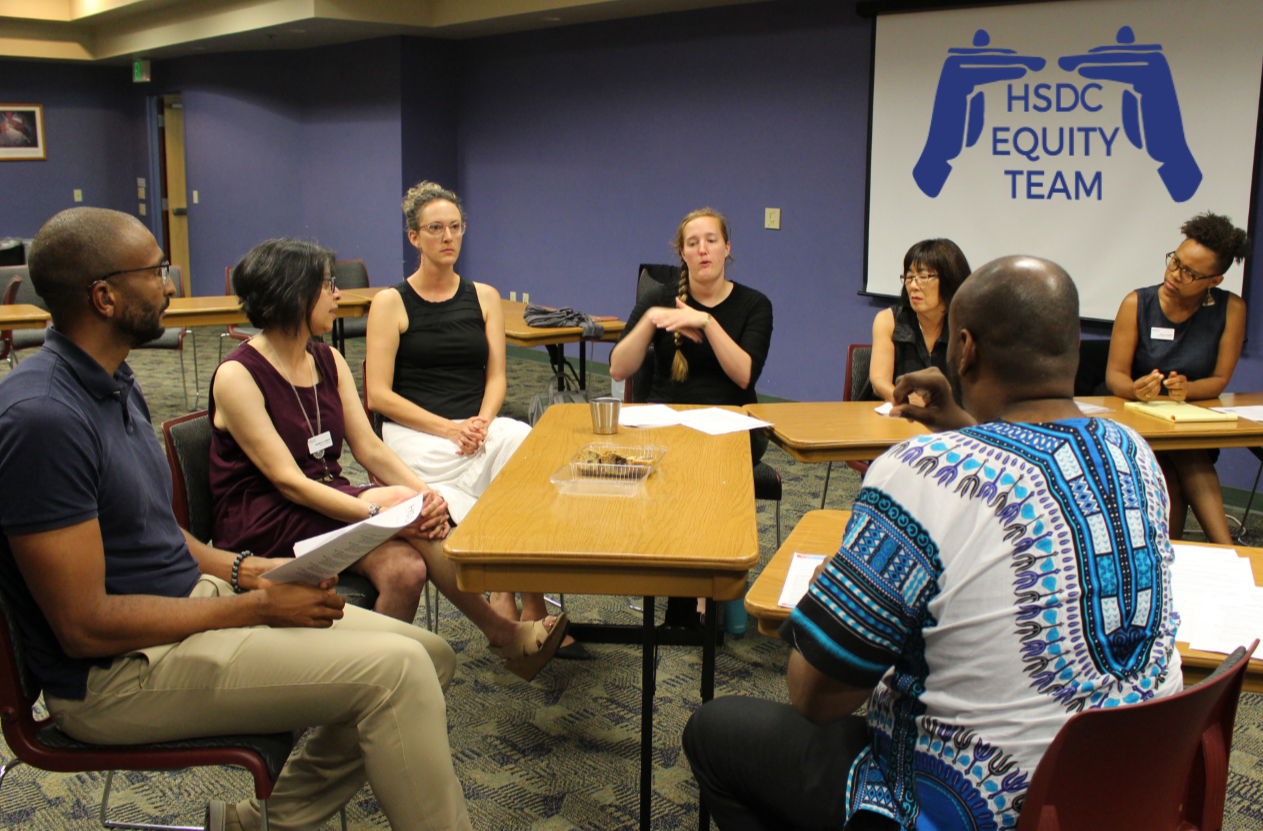[image description: The HSDC Equity team meeting in a conference room with blue walls. Seven people sit around brown folding tables. From left to right: a dark-skinned person with close-cropped hair, a light-skinned person with short black hair, a light-skinned person with curly blonde and brunette hair, a light-skinned person with long brown hair, a light-skinned person with short black hair, a dark-skinned person with close-cropped hair, and a dark-skinned person with hair that is tall on the top.]
HSDC Equity Team Update
[image description: Embedded YouTube video of an ASL video for this article. A dark-skinned man in a light blue polo shirt is in front of a blue background.]
August marked the start of a new operating year for the Equity Team. During the upcoming year, we will continue addressing racial equity, while adding a parallel focus on audism.
Audism is the belief that people who hear, and people who have the ability to behave like a hearing person, are superior to Deaf people. The term was coined in an unpublished 1975 essay by Tom Humphries, a Deaf scholar. It was not widely used until another Deaf scholar named Harlan Lane published his famous book, Mask of Benevolence, in 1992.
Deaf and hard of hearing people face audism every day, in the form of communication barriers, discrimination, or hostile attitudes. Like other forms of oppression, audism prevents deaf and hard of hearing people from achieving their true potential. The consequences of audism include language deprivation, isolation, and widespread poverty, among others.
The Equity Team decided to address audism now because it impacts all of our staff and clients. We can use our knowledge of institutional racism to understand how audism functions on an institutional level. Tackling audism directly will help HSDC to better support Deaf, DeafBlind, hard of hearing, and late-deafened people in the community, including our staff, clients, and supporters.
If you’d like to learn more about audism, we recommend the following resources:
- A video interview with Deaf scholar Ben Bahan, who defines “audism”, “Deaf gain”, and “Deafhood”.
- For a simple written explanation, check out “The Meaning and Practice of Audism” by Verywell Health.
- For a written academic perspective, read “Audism: Exploring the Metaphysics of Oppression” by H-Dirksen L. Bauman.
- A short cartoon with 5 examples of audism by Ai-Media.
Audism isn’t the fault of individual hearing people. However, all hearing people do have a responsibility to address audism, just as white people have a responsibility to address and fight against racism. The Equity Team will work to find the best way to address audism within HSDC so that our organization can continue empowering Deaf people and be an accessibility leader in the local community.
Racial equity and audism are both part of the intersectionality existing in HSDC and all of society. Oppression harms everyone, and makes it impossible for HSDC to achieve our mission of an inclusive, accessible world. Tackling racial equity and audism at the same time will be a challenge, but the Equity Team believes that we cannot continue our work without addressing these parallel oppressions.
For a written academic perspective on the intersectionality of race and audism, we recommend ”Inclusive Deaf Studies: Barriers and Pathways” by Janes K. Fernandes and Shirley Shultz Myers.
Do you have suggestions for how the Equity Team can address racial equity and audism? Email [email protected].
Sources
Audism: Exploring the Metaphysics of Oppression (PDF)
Deaf History Month: Audism (Video)
Effects of Linguisticism and Audism on the Developing Deaf Person (Video)
